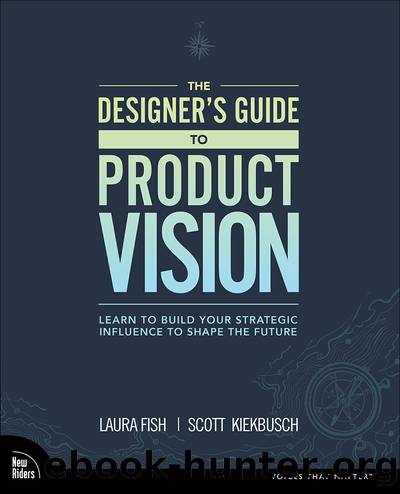The Designer's Guide to Product Vision: Learn to build your strategic influence to shape the future by Laura Fish & Scott Kiekbusch

Author:Laura Fish & Scott Kiekbusch [Laura Fish]
Language: eng
Format: epub
Publisher: New Riders
Published: 2020-08-01T16:00:00+00:00
Slide: The Problem
Before diving into the nuts and bolts of writing problem statements, let’s clarify the semantics of the word problem so that you’re not put off by the negative connotation of the word. A problem in the sense of a strategy isn’t necessarily harmful to the person. The user problems that we tend to focus on from a design standpoint are more akin to scientific or mathematical problems.
The problems we’re identifying have a strong relationship to “Jobs” in the Jobs-To-Be-Done Framework. They may be tasks a person needs to complete or impediments to goals they want to achieve. Often defining a user problem can focus on ways to make a process more convenient, simpler, or more effective. Problems can be large, such as “Help me save for retirement.” Problems can be small, like “I can’t find the Submit button.” Either way, user problem statements will articulate a user need without telegraphing a solution. For the purposes of a strategy phase and product vision, you’re almost certain to be focusing on problems that are larger in scope than minor usability issues.
The research activities that your team has done will undoubtedly uncover a slew of problems that can be written as problem statements. It’s helpful for teams to have an agreed-on format to define problems consistently. The following syntax works well for defining broad, overarching problems that can be addressed via the product strategy: “I am a ______ trying to ______ but ______ because ______ , which makes me feel ______ .”
The beginning, “I am a ______ ,” allows for a simple description of the user as well as an opportunity to provide some context about the situation. Using “I” rather than “you” in the problem statement helps team members feel personal ownership and connection to the problem. Avoid simply writing something like “I am a customer,” or “I am a user.” Aim for something like this: “I am a busy mother of three young children on my way home from work.” This line should immediately conjure an image of a real person and start the empathy process.
“Trying to ______” is the user’s desired outcome. “But ______” is the barrier, and “because ______” is the root cause of the problem. Understanding the desired outcome, barrier, and broader root cause of the barrier can lead to teams thinking of more creative ways to solve the problem.
Finally, “which makes me feel ______” is an explicit description of the user’s emotional state related to the problem. The last line is intended to further build empathy and create a deeper connection with the team whose job it is to design solutions to the stated problem.
For example, this is the problem statement for our “uncertain” persona, defined in the previous target user slide:
I am . . . a busy hiring manager at a large company.
Download
This site does not store any files on its server. We only index and link to content provided by other sites. Please contact the content providers to delete copyright contents if any and email us, we'll remove relevant links or contents immediately.
Algorithms of the Intelligent Web by Haralambos Marmanis;Dmitry Babenko(9832)
Azure Data and AI Architect Handbook by Olivier Mertens & Breght Van Baelen(7611)
Building Statistical Models in Python by Huy Hoang Nguyen & Paul N Adams & Stuart J Miller(7593)
Serverless Machine Learning with Amazon Redshift ML by Debu Panda & Phil Bates & Bhanu Pittampally & Sumeet Joshi(7478)
Data Wrangling on AWS by Navnit Shukla | Sankar M | Sam Palani(7237)
Driving Data Quality with Data Contracts by Andrew Jones(7232)
Machine Learning Model Serving Patterns and Best Practices by Md Johirul Islam(6964)
Learning SQL by Alan Beaulieu(6211)
Weapons of Math Destruction by Cathy O'Neil(6143)
Big Data Analysis with Python by Ivan Marin(5883)
Data Engineering with dbt by Roberto Zagni(4899)
Solidity Programming Essentials by Ritesh Modi(4529)
Time Series Analysis with Python Cookbook by Tarek A. Atwan(4359)
Pandas Cookbook by Theodore Petrou(4057)
Blockchain Basics by Daniel Drescher(3507)
Natural Language Processing with Java Cookbook by Richard M. Reese(3100)
Hands-On Machine Learning for Algorithmic Trading by Stefan Jansen(3027)
Feature Store for Machine Learning by Jayanth Kumar M J(2908)
Learn T-SQL Querying by Pam Lahoud & Pedro Lopes(2878)
